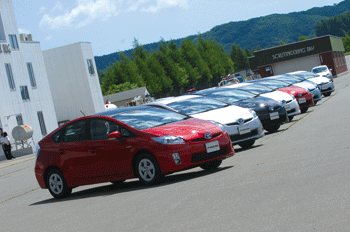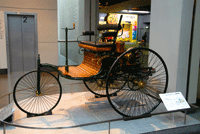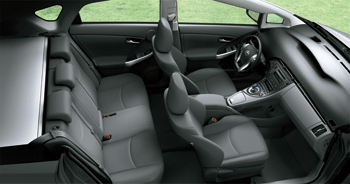The third-generation Toyota Prius hybrid is a mean machine but isn’t really everyone’s cup of tea. Glen Watson goes on a test drive in Japan

An invitation to Toyota City, near Nagoya, to experience the latest Toyota Prius was tempting, especially when the six-day itinerary included a trip to the northern island of Hokkaido for a test drive on a racetrack.
I’ve driven more than 100 cars, but never a Prius hybrid – a term which refers to it having both electric and petrol engines. The car entered the Japanese market in 1997 and over 1.2 million have been sold around the world. I’m fascinated by the debates over whether it is just “green marketing” (as Top Gear, South Park and many others suggest) or more harmful to the environment than owning an SUV (Wired magazine, June 2008).
The itinerary was precise and unrelenting – got on the bus in the morning, visited Toyota museums and other sights before returning to the hotel late in the evening, exhausted but extremely well-fed, thanks to Japanese hospitality and the excellent cuisine. It all began with a bumpy four-hour Cathay Pacific flight from Hongkong to Nagoya (population: about 2.5 million) in central Japan.
The Nagoya Hilton’s 30sqm standard twin-bed rooms were comfortable, if not exactly spacious (the rooms on the Executive Floors are the same size). Besides the Japanese and porn pay channels, there were several free English TV channels, including Discovery, CNN and BBC. High-speed internet was available. A copy of The Japan Times was slipped under my door before I woke each day at 7am. The breakfast buffet was adequate and offered Japanese, Western and Chinese fare. The coffee, however, was excellent.
The Naka-ku area around the hotel offers the peaceful Shirakawa Park, an abundance of bars (thankfully, not all have hostesses), the excellent but tiny Cigar Club Kanou, a Starbucks, a Mos Burger, Hard Rock Café, many high-end shops and several massive shopping centres – including one that’s completely underground. Other sights worth visiting are Nagoya Castle (built in 1612 and restored in 1959), Atsuta Shrine and the Nagoya/Boston Museum of Fine Art.
I was with about 40 Asian journalists and we visited nearby Toyota City and other places relating to the history of Toyota Motor Corporation. We were given special access to the Toyota Automobile Museum (closed on Mondays). This included taking a spin indoors on an i-Real – a four-wheel concept vehicle that’s quite similar to a futuristic wheelchair except that when seated, the driver remains at about eye-level with someone who is standing. At least, that’s when it is in slow mode (about 3km/h). Press the button for fast mode and the machine lowers, the wheelbase lengthens and it can go more than 20km/h on paved roads. Having tried a Segway previously, I concluded that the i-Real was more comfortable and easier to control. They are tentatively slated to go into production next year.
 This museum should be on everyone’s to-do list when visiting this part of Japan. For ¥1,000 (US$10), you get a fantastic look at the history of the automobile, including the 1936 Toyoda Model AA Sedan – the company’s first passenger car.
This museum should be on everyone’s to-do list when visiting this part of Japan. For ¥1,000 (US$10), you get a fantastic look at the history of the automobile, including the 1936 Toyoda Model AA Sedan – the company’s first passenger car.
Toyota was originally called Toyoda, after the family name of founder Sakichi Toyoda, but was changed to Toyota as this word has an auspicious eight-character strokes (instead of 10 for Toyoda) in the Japanese writing system. Toyota Motor Corporation was founded by his son, Kiichiro, in 1937. This year, grandson Akio became president and CEO of the car company.
Toyota’s tree-lined Tsutsumi Plant, where many Prius cars are built, is part of Toyota’s “green” initiative, with solar panels and grass on rooftops. We were told that some buildings are covered with a special paint to help reduce pollution. Nearly all material used to create a Prius is recyclable and the plant produces no landfill waste. A new Prius comes off the line every 66 seconds. We also went to the Toyota Commemorative Museum in Nagoya. The original Toyoda company was involved in spinning cotton.
The next day, we were taken to Komaki domestic airport for a 100-minute flight to Obihiro, a model environmental city (population: 170,000) in southern Hokkaido’s Tokachi Province. After landing, a bus took us into the countryside to visit Shichiku Garden for a stroll and some soft ice-cream made using the milk produced in this flat, agricultural region. We also dropped by the upscale candy shop Rokkatei before we got to the Nikko Northland Hotel, which is beside the JR train station (I never heard a train passing by). Sapporo is about a 2.5-hour train ride away in the northern part of the island. Later, we visited the Tokachi Wine Castle, where the local wine is made.
Finally, it was time to drive the Prius around the Tokachi International Speedway. I was so excited that I woke at first light, only to discover that the sun rose at about 4am during summer. After a briefing at the track, the first test was for fuel efficiency while driving three laps around the track. The new Prius is rated at 38km/l (89.4mpg). For the first two laps, I drove with a window down (which is normal on a hot day). The final lap was with the windows up and the air-con running. I averaged about 30.2km/l, but the track wasn’t hilly and there were no starts-stops due to traffic lights etc.

Then I drove it in EV mode, which uses only the electric motor and not the petrol one. The new Prius can go up to 30km/h for about 3km in this mode, which is practically silent. There is a slight hum, similar to an electric train. Another test involved putting four golf bags in the trunk and five people in the seats.
The last test was for basic performance over 12 laps, including lane changes and cornering at high-speed. The Prius did very well, thanks in large part to the improved vehicle stability control. On a long straightaway, I managed to go 172km/h. Not very fuel-efficient, but I was surprised that it went so fast. But it took a long 10.4 seconds to go from zero to 100km/h.
The Prius is a comfortable and well-built car (Toyota recently received the top marks from JD Power and Associates for new vehicle quality). The buttons and dials are well-placed and the heads-up display is a nice touch. But driving to achieve maximum fuel-efficiency would probably enrage nearby drivers as this requires very slow starts, little passing and low speeds.
People will still have concerns about the Prius’ “green” claims, especially since the ingredients for the nickel-metal hydride (Ni-MH) batteries are mined in Canada and shipped around the world before they are processed and installed in the Prius. The batteries have a lifespan of about 10 years before they are, hopefully, recycled. Toyota plans to use lithium-ion batteries within a few years.
The bottom line is, if you like the Prius and need a new car, then get one. It’s a well-built, full-size car that performs well and improves on the previous generations. Whether it meets all of its green goals is unclear. The Prius isn’t really my cup of tea mainly because I’m not crazy about the aerodynamic design (with a drag coefficient of 0.25) or the extra cost. I would think about renting one while on vacation in Japan or elsewhere, if it were available. It might be worth waiting to buy one. Toyota says it plans to introduce a plug-in version of the Prius by 2013 and a fuel-cell car by 2015.
For more information, log on to www.toyota.com/prius-hybrid
Glen Watson

I’ve driven more than 100 cars, but never a Prius hybrid – a term which refers to it having both electric and petrol engines. The car entered the Japanese market in 1997 and over 1.2 million have been sold around the world. I’m fascinated by the debates over whether it is just “green marketing” (as Top Gear, South Park and many others suggest) or more harmful to the environment than owning an SUV (Wired magazine, June 2008).
The itinerary was precise and unrelenting – got on the bus in the morning, visited Toyota museums and other sights before returning to the hotel late in the evening, exhausted but extremely well-fed, thanks to Japanese hospitality and the excellent cuisine. It all began with a bumpy four-hour Cathay Pacific flight from Hongkong to Nagoya (population: about 2.5 million) in central Japan.
The Nagoya Hilton’s 30sqm standard twin-bed rooms were comfortable, if not exactly spacious (the rooms on the Executive Floors are the same size). Besides the Japanese and porn pay channels, there were several free English TV channels, including Discovery, CNN and BBC. High-speed internet was available. A copy of The Japan Times was slipped under my door before I woke each day at 7am. The breakfast buffet was adequate and offered Japanese, Western and Chinese fare. The coffee, however, was excellent.
The Naka-ku area around the hotel offers the peaceful Shirakawa Park, an abundance of bars (thankfully, not all have hostesses), the excellent but tiny Cigar Club Kanou, a Starbucks, a Mos Burger, Hard Rock Café, many high-end shops and several massive shopping centres – including one that’s completely underground. Other sights worth visiting are Nagoya Castle (built in 1612 and restored in 1959), Atsuta Shrine and the Nagoya/Boston Museum of Fine Art.
I was with about 40 Asian journalists and we visited nearby Toyota City and other places relating to the history of Toyota Motor Corporation. We were given special access to the Toyota Automobile Museum (closed on Mondays). This included taking a spin indoors on an i-Real – a four-wheel concept vehicle that’s quite similar to a futuristic wheelchair except that when seated, the driver remains at about eye-level with someone who is standing. At least, that’s when it is in slow mode (about 3km/h). Press the button for fast mode and the machine lowers, the wheelbase lengthens and it can go more than 20km/h on paved roads. Having tried a Segway previously, I concluded that the i-Real was more comfortable and easier to control. They are tentatively slated to go into production next year.
 This museum should be on everyone’s to-do list when visiting this part of Japan. For ¥1,000 (US$10), you get a fantastic look at the history of the automobile, including the 1936 Toyoda Model AA Sedan – the company’s first passenger car.
This museum should be on everyone’s to-do list when visiting this part of Japan. For ¥1,000 (US$10), you get a fantastic look at the history of the automobile, including the 1936 Toyoda Model AA Sedan – the company’s first passenger car. Toyota was originally called Toyoda, after the family name of founder Sakichi Toyoda, but was changed to Toyota as this word has an auspicious eight-character strokes (instead of 10 for Toyoda) in the Japanese writing system. Toyota Motor Corporation was founded by his son, Kiichiro, in 1937. This year, grandson Akio became president and CEO of the car company.
Toyota’s tree-lined Tsutsumi Plant, where many Prius cars are built, is part of Toyota’s “green” initiative, with solar panels and grass on rooftops. We were told that some buildings are covered with a special paint to help reduce pollution. Nearly all material used to create a Prius is recyclable and the plant produces no landfill waste. A new Prius comes off the line every 66 seconds. We also went to the Toyota Commemorative Museum in Nagoya. The original Toyoda company was involved in spinning cotton.
The next day, we were taken to Komaki domestic airport for a 100-minute flight to Obihiro, a model environmental city (population: 170,000) in southern Hokkaido’s Tokachi Province. After landing, a bus took us into the countryside to visit Shichiku Garden for a stroll and some soft ice-cream made using the milk produced in this flat, agricultural region. We also dropped by the upscale candy shop Rokkatei before we got to the Nikko Northland Hotel, which is beside the JR train station (I never heard a train passing by). Sapporo is about a 2.5-hour train ride away in the northern part of the island. Later, we visited the Tokachi Wine Castle, where the local wine is made.
Finally, it was time to drive the Prius around the Tokachi International Speedway. I was so excited that I woke at first light, only to discover that the sun rose at about 4am during summer. After a briefing at the track, the first test was for fuel efficiency while driving three laps around the track. The new Prius is rated at 38km/l (89.4mpg). For the first two laps, I drove with a window down (which is normal on a hot day). The final lap was with the windows up and the air-con running. I averaged about 30.2km/l, but the track wasn’t hilly and there were no starts-stops due to traffic lights etc.

Then I drove it in EV mode, which uses only the electric motor and not the petrol one. The new Prius can go up to 30km/h for about 3km in this mode, which is practically silent. There is a slight hum, similar to an electric train. Another test involved putting four golf bags in the trunk and five people in the seats.
The last test was for basic performance over 12 laps, including lane changes and cornering at high-speed. The Prius did very well, thanks in large part to the improved vehicle stability control. On a long straightaway, I managed to go 172km/h. Not very fuel-efficient, but I was surprised that it went so fast. But it took a long 10.4 seconds to go from zero to 100km/h.
The Prius is a comfortable and well-built car (Toyota recently received the top marks from JD Power and Associates for new vehicle quality). The buttons and dials are well-placed and the heads-up display is a nice touch. But driving to achieve maximum fuel-efficiency would probably enrage nearby drivers as this requires very slow starts, little passing and low speeds.
People will still have concerns about the Prius’ “green” claims, especially since the ingredients for the nickel-metal hydride (Ni-MH) batteries are mined in Canada and shipped around the world before they are processed and installed in the Prius. The batteries have a lifespan of about 10 years before they are, hopefully, recycled. Toyota plans to use lithium-ion batteries within a few years.
The bottom line is, if you like the Prius and need a new car, then get one. It’s a well-built, full-size car that performs well and improves on the previous generations. Whether it meets all of its green goals is unclear. The Prius isn’t really my cup of tea mainly because I’m not crazy about the aerodynamic design (with a drag coefficient of 0.25) or the extra cost. I would think about renting one while on vacation in Japan or elsewhere, if it were available. It might be worth waiting to buy one. Toyota says it plans to introduce a plug-in version of the Prius by 2013 and a fuel-cell car by 2015.
For more information, log on to www.toyota.com/prius-hybrid
Glen Watson








